
- Home
- Travel Packages
- Top Destination
-
Travel Attraction
By Category
Top Attraction

- Travel Agents
- Car Rentals
- Hotels
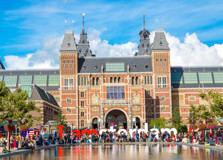
The Rijksmuseum is one of the most famous and significant museums in the Netherlands. Located in the heart of Amsterdam, it is known for its rich collection of art, history, and culture. The museum holds masterpieces from the Dutch Golden Age, including works by Rembrandt, Vermeer, and Frans Hals. With over 8,000 pieces on display and more than a million items in its collection, the Rijksmuseum offers a deep dive into the Dutch heritage through paintings, sculptures, artifacts, and decorative arts. How to Reach Rijksmuseum, Amsterdam The Rijksmuseum is located at Museumstraat 1, 1071 XX Amsterdam, in the Museumplein area. It is easily accessible by different modes of transport: By Tram: Take tram numbers 2, 5, or 12 to the Rijksmuseum stop. It's just a few steps from the entrance. By Bus: Several buses, including 347 and 357, stop near the Museumplein area. By Bicycle: Amsterdam is very bike-friendly, and there are bike racks available near the museum. By Car: Parking is available at Q-Park Museumplein, a few minutes' walk from the museum. Weather Around Rijksmuseum Amsterdam experiences four distinct seasons, and the weather can impact your overall museum visit, especially if you’re planning to explore the surrounding area as well: Spring (March to May): Mild and pleasant, with tulips in bloom. Temperatures range from 8°C to 18°C. Summer (June to August): Warm and ideal for outdoor activities, with temperatures between 17°C to 26°C. Autumn (September to November): Cool with occasional rain. Trees turn beautiful shades of orange and yellow. Winter (December to February): Cold and often damp, with temperatures between 0°C to 7°C. The museum offers a warm indoor escape. Timings to Visit Rijksmuseum The Rijksmuseum is open daily, including weekends and most holidays. Opening Hours: 9:00 AM – 5:00 PM Last Admission: Entry allowed until 4:30 PM Closed On: Open all year round, including holidays Why Famous for Rijksmuseum, Amsterdam? The Rijksmuseum is famous for its extensive and impressive collection of Dutch art, especially paintings from the 17th century, known as the Dutch Golden Age. The museum houses world-renowned artworks like Rembrandt's The Night Watch and Vermeer’s The Milkmaid. It is also celebrated for its stunning architecture and beautiful interior design. Beyond art, the museum features historical objects, furniture, fashion, and even a vast library. Entry and Visit Details Entry Fee: Adults – €22.50; Free for children under 18 Audio Guide: Available in multiple languages for €5; downloadable app also available for free Tickets: Recommended to buy online to avoid queues, especially during peak season Photography: Allowed without flash in most areas History and Architecture The Rijksmuseum was founded in 1800 in The Hague and later moved to Amsterdam in 1808. The current building, designed by architect Pierre Cuypers, was opened in 1885 and is a stunning example of Dutch Neo-Gothic architecture. The design combines elements of Gothic and Renaissance styles, with large arched windows, detailed brickwork, and beautifully decorated interiors. The museum underwent a major renovation between 2003 and 2013, which modernized its facilities while preserving its historic charm. Today, the building itself is a masterpiece that enhances the cultural experience of the visitors. Things to Do at Rijksmuseum Explore the Masterpieces: Admire paintings by Rembrandt, Vermeer, Van Gogh, and other great artists. Visit the Library: The Cuypers Library is one of the oldest and most beautiful art libraries in the world. Take a Guided Tour: Join an expert-led tour to learn detailed stories behind the artworks. Enjoy the Garden: The museum gardens are free to enter and host seasonal art installations. Relax at the Café: The museum café offers meals and refreshments with a cozy ambiance. Visit the Gift Shop: Buy art-themed souvenirs, books, and prints inspired by the museum’s collection. Interesting Facts The museum’s collection includes over 1 million objects, but only about 8,000 are on display at a time. Rembrandt’s The Night Watch has its own dedicated gallery due to its size and popularity. The Rijksmuseum building has a bicycle path running through its central archway — a unique architectural feature. There’s a hidden chapel inside the museum, which is now used for special exhibitions. The Rijksmuseum was the first museum in the world to digitize and offer its collection freely online through the Rijksstudio platform. Tips for Visiting Rijksmuseum Buy Tickets in Advance: Booking online helps you skip the long queues, especially during holidays and weekends. Start Early: Arriving early allows you to enjoy popular artworks before the museum gets crowded. Use the Rijksmuseum App: It offers interactive maps and detailed guides for a self-paced tour. Plan for at Least 2–3 Hours: There is a lot to see, so take your time to explore the highlights and exhibits. Combine with Nearby Attractions: The Van Gogh Museum and Stedelijk Museum are just next door, and Vondelpark is perfect for a post-visit walk. The Rijksmuseum is more than just a museum — it’s a cultural journey through Dutch history and artistic excellence. Whether you're an art lover, a history buff, or a curious traveler, a visit to this iconic museum is a must when in Amsterdam.
Explore More
The Van Gogh Museum in Amsterdam is one of the most popular art museums in the world. It is dedicated to the life and work of the Dutch painter Vincent van Gogh. Located in the heart of Amsterdam’s Museumplein (Museum Square), the museum holds the largest collection of Van Gogh’s paintings, drawings, and letters. It attracts millions of visitors each year who come to admire the colorful, emotional, and expressive artworks of one of the most influential artists in history. How to Reach Van Gogh Museum, Amsterdam The Van Gogh Museum is located at Museumplein 6, 1071 DJ Amsterdam. Getting there is easy with several transportation options: By Tram: Trams 2, 5, and 12 stop at the Rijksmuseum or Van Baerlestraat, both of which are a short walk away from the museum. By Bus: Bus lines 347, 357, and 397 from Amsterdam Central Station stop nearby. By Bicycle: Amsterdam is a bike-friendly city, and there are plenty of bike racks around Museumplein. By Car: Parking is available at Q-Park Museumplein, but driving in Amsterdam can be tricky due to traffic and limited parking spaces. Weather Around Van Gogh Museum Amsterdam’s weather varies by season, and this may affect your travel plans. However, since the Van Gogh Museum is indoors, it’s a great attraction any time of the year. Spring (March to May): Pleasant weather with blooming tulips; average temperatures between 8°C to 17°C. Summer (June to August): Warm and sunny with highs of 20°C to 25°C; a popular time for tourists. Autumn (September to November): Cooler and occasionally rainy; temperatures range from 10°C to 18°C. Winter (December to February): Cold and damp with temperatures around 2°C to 7°C; fewer crowds in the museum. Timings to Visit Van Gogh Museum The museum is open every day, including weekends and most public holidays. Opening Hours: Typically 9:00 AM – 5:00 PM, extended hours on Fridays until 9:00 PM Last Admission: 30 minutes before closing time Best Time to Visit: Early morning or late afternoon to avoid the largest crowds Why Famous for Van Gogh Museum, Amsterdam? The Van Gogh Museum is famous for being the world’s largest and most comprehensive collection of Vincent van Gogh’s works. The museum houses over 200 paintings, 500 drawings, and more than 700 letters written by the artist. Highlights include masterpieces such as Sunflowers, The Bedroom, Almond Blossom, and Wheatfield with Crows. It also showcases his life story, struggles with mental health, and evolution as an artist, making it an emotional and inspiring experience. Entry and Visit Details Tickets: Adults – €20; Free for children under 18 Online Booking: Recommended due to high visitor numbers; time slots are required Audio Guide: Available in multiple languages for €3.50; app version also available for download Accessibility: Wheelchair accessible; free entrance for disabled visitors and one companion Photography: Not allowed in most galleries to protect the artworks History and Architecture The Van Gogh Museum was officially opened in 1973. The original building was designed by Dutch architect Gerrit Rietveld, a pioneer of modernist architecture. Its design is clean, minimalist, and functional. In 1999, a new exhibition wing designed by Japanese architect Kisho Kurokawa was added. This modern extension features a curved glass entrance and provides more space for temporary exhibitions and special events. The combination of Rietveld’s classic modernist design and Kurokawa’s elegant modern architecture makes the museum a visual treat inside and out. The layout allows for a chronological display of Van Gogh’s life and work, making it easy for visitors to follow his artistic development. Things to Do at Van Gogh Museum Explore the Permanent Collection: Discover Van Gogh’s iconic paintings, drawings, and personal letters. Visit Temporary Exhibitions: The museum often features rotating exhibitions focused on Van Gogh’s influences or other related artists. Use the Multimedia Guide: Learn more about each piece with audio explanations and insights into Van Gogh’s techniques and emotions. Family Activities: There are interactive exhibits and workshops designed for children and families. Shop at the Museum Store: Buy art prints, books, gifts, and souvenirs inspired by Van Gogh’s work. Enjoy the Café Le Tambourin: Relax with coffee or lunch at the stylish museum café overlooking Museumplein. Interesting Facts Vincent van Gogh only sold one painting during his lifetime, yet today his works are some of the most valuable in the world. The museum receives over 2 million visitors annually from around the globe. Many of the letters on display were written by Van Gogh to his brother Theo, providing personal insight into his life. The museum’s building is a prime example of De Stijl architectural style in the Netherlands. Van Gogh created more than 2,100 artworks in just 10 years of painting. Tips for Visiting Van Gogh Museum Book Early: Buy tickets online and reserve a time slot, especially during summer or weekends. Allow 2 Hours: The museum can be fully explored in 2 to 2.5 hours at a comfortable pace. Start with the Top Floor: Begin your visit at the top and work your way down to follow Van Gogh’s life chronologically. Download the App: The Van Gogh Museum app includes an audio tour and digital map for easier navigation. Check for Exhibitions: Look at the museum’s website to see if there are any temporary shows or special events during your visit. A visit to the Van Gogh Museum is a moving and enlightening experience. Whether you’re an art lover, a history enthusiast, or just curious about Van Gogh’s life, this museum offers a unique and emotional journey through the mind and masterpiece of one of the world’s most celebrated artists.
Explore More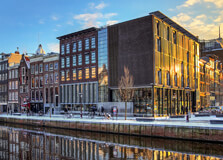
The Anne Frank House in Amsterdam is one of the most powerful and moving museums in the world. It preserves the hiding place where Anne Frank, a young Jewish girl, wrote her famous diary during World War II. Visiting this museum offers a deep insight into the horrors of the Holocaust, the effects of war, and the resilience of the human spirit. It is not just a museum, but a place of remembrance, reflection, and education. How to Reach Anne Frank House, Amsterdam The Anne Frank House is located at Prinsengracht 263-267, in the center of Amsterdam. It is easy to access by public transportation or on foot: By Tram: Take tram 13 or 17 and get off at the Westermarkt stop, which is just a few minutes’ walk from the museum. By Bus: Bus numbers 170, 171, and 172 also stop near the Westermarkt. From Amsterdam Central Station: It’s about a 20-minute walk or a 10-minute ride by tram or bus. By Bicycle: Amsterdam is a bicycle-friendly city, and there are bike racks near the museum. Weather Around Anne Frank House The Anne Frank House is an indoor museum, so it can be visited all year round regardless of the weather. However, knowing the general weather conditions of Amsterdam helps in planning your day: Spring (March to May): Mild and comfortable weather; temperatures range from 8°C to 17°C. Summer (June to August): Warm and popular with tourists; temperatures range from 18°C to 25°C. Autumn (September to November): Cool and often rainy; temperatures range from 10°C to 18°C. Winter (December to February): Cold and gray, but fewer crowds; temperatures around 2°C to 7°C. Timings to Visit Anne Frank House The museum is open seven days a week, including holidays. Opening Hours: Usually from 9:00 AM to 10:00 PM Last Entry: 30 minutes before closing Best Time to Visit: Early morning or late evening for fewer crowds Why Famous for Anne Frank House, Amsterdam? The Anne Frank House is famous because it was the secret hiding place where Anne Frank and her family lived in fear for more than two years during the Nazi occupation of the Netherlands. Anne documented her daily life in her now-famous diary, which has since become one of the most widely read books in the world. The museum is visited by millions each year who want to understand her story, honor the victims of the Holocaust, and promote tolerance and human rights. Entry and Visit Details Tickets: Must be purchased online in advance. Adults: €16, Ages 10–17: €7, Under 10: €1 Online Booking: Required. No tickets sold at the door. Visit Duration: Most people spend about 1.5 to 2 hours in the museum. Accessibility: The old house is not wheelchair accessible, but the modern annex with exhibits is accessible. Photography: Not allowed inside to respect the historical setting and privacy. History and Architecture The Anne Frank House was originally a canal-side building built in the 17th century. During World War II, it served as the secret annex where Otto Frank, his wife Edith, their daughters Anne and Margot, and four others hid from the Nazis. The hidden rooms are located behind a movable bookcase in Otto Frank’s office building. After the war, Otto Frank, the only survivor from the group, made it his mission to publish Anne’s diary and preserve the hiding place. In 1960, the museum officially opened. The original structure has been carefully preserved, and a modern extension was added to host exhibitions and educational programs. Visitors can walk through the secret annex, climb the steep stairs, and feel the silence and tension of those who lived there in fear. Things to Do at Anne Frank House Tour the Secret Annex: Walk through the original hiding space where Anne Frank wrote her diary. View the Exhibits: Learn more about the Holocaust, anti-Semitism, and Anne’s life through photos, videos, and personal items. See the Diary: Anne’s original red-checked diary is on display and is one of the museum’s most moving exhibits. Visit the Bookshop: Buy books in many languages, including “The Diary of a Young Girl.” Attend Lectures: Educational programs and presentations are offered, especially for students. Interesting Facts Anne Frank wrote her famous diary from age 13 to 15 while hiding in the annex. The museum receives over 1.2 million visitors each year. Otto Frank, Anne’s father, was the only person from the annex who survived the concentration camps. The secret annex was hidden behind a movable bookshelf built by trusted colleagues. The diary has been translated into over 70 languages and has sold more than 30 million copies worldwide. Tips for Visiting Anne Frank House Book Early: Tickets sell out quickly, often weeks in advance. Book online at the official website. Prepare Emotionally: The museum is deeply moving and can be emotional, especially for young visitors. Arrive on Time: Entry is based on timed slots, and late arrivals may not be allowed in. No Bags: Large bags are not allowed inside. Use the lockers provided. Read the Diary: Reading Anne’s diary before your visit can help you connect more deeply with the experience. A visit to the Anne Frank House is much more than a museum tour. It’s a journey through history, a lesson in humanity, and a reminder of the importance of tolerance, freedom, and justice. It’s a must-visit for anyone coming to Amsterdam, especially those who value human rights and want to keep Anne’s memory alive.
Explore More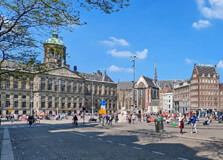
Dam Square is one of the most famous and busiest public squares in the heart of Amsterdam, Netherlands. Located just a short walk from Amsterdam Central Station, it is a lively and historic location that attracts both tourists and locals. Surrounded by important buildings and monuments, including the Royal Palace and the National Monument, Dam Square is a cultural, political, and social hub of the city. How to Reach Dam Square, Amsterdam Dam Square is easily accessible from any part of Amsterdam due to its central location: By Foot: If you're near the city center, it's a short and pleasant walk from most tourist areas. By Tram: Several tram lines (1, 2, 4, 5, 13, 14, 17, 24) stop right at Dam Square. From Amsterdam Central Station: It's about a 5-minute walk (700 meters) south of the station. By Bus: Many city buses stop nearby or at the Central Station. By Bicycle: Amsterdam is bike-friendly with plenty of parking options near the square. Weather at Dam Square Since Dam Square is an open-air public space, the weather plays a key role in your experience: Spring (March–May): Pleasant weather with temperatures between 8°C to 17°C. Great for walking tours. Summer (June–August): Warm and ideal for sightseeing, with temperatures ranging from 18°C to 25°C. Also the busiest season. Autumn (September–November): Cooler weather with frequent rain. Pack a jacket and umbrella. Winter (December–February): Cold and less crowded. Temperatures range from 0°C to 7°C. Festive lights decorate the square during holidays. Timings to Visit Dam Square Dam Square is open 24 hours a day and does not require tickets to enter. It is a public space, so you can visit anytime: Best Time: Morning or evening to avoid heavy crowds. Sunset offers great photo opportunities. Events: Check local schedules as the square often hosts public events, festivals, and parades. Why Famous for Dam Square, Amsterdam? Dam Square is famous because it is one of the oldest and most significant places in Amsterdam. Originally a dam built on the Amstel River in the 13th century, it eventually became the center of town life. Today, it is surrounded by landmarks like the Royal Palace, the Nieuwe Kerk (New Church), the National Monument, Madame Tussauds, and luxury shops and restaurants. The square has witnessed historical events, royal celebrations, political speeches, and public demonstrations. It is a place where history and modern life coexist. The lively atmosphere, street performers, and beautiful architecture make it a must-visit spot. Entry and Visit Details about Dam Square Entry Fee: Free. It's a public square with open access. Facilities: Nearby cafes, restaurants, shops, public toilets, and benches. Accessibility: Wheelchair accessible and suitable for all age groups. Nearby Transport: Trams, taxis, and walking paths are easily available. History and Architecture Dam Square gets its name from the dam that was built around 1270 to protect the city from flooding by the Amstel River. Over time, a town grew around this dam, and Amsterdam was born. The square was historically a trading hub, with markets, civic buildings, and public gatherings. One of the most iconic buildings is the Royal Palace (Koninklijk Paleis), built in the 17th century as the city hall. It showcases Dutch Classicism architecture with a grand sandstone façade and richly decorated interiors. It later became a royal residence. The Nieuwe Kerk (New Church) is another historic building on the square, dating back to the 15th century. Today, it hosts exhibitions and royal ceremonies. In the center of the square stands the National Monument, built in 1956 to honor the victims of World War II. This white stone pillar is surrounded by sculptures and serves as a site for national remembrance. Things to Do at Dam Square Visit the Royal Palace: Take a guided tour inside the historic palace and explore its grand halls. Explore Madame Tussauds: See life-like wax figures of celebrities and historical figures. Relax by the National Monument: Sit down, reflect, and watch the daily life of Amsterdam pass by. Street Performers: Enjoy music, magic shows, and living statues all around the square. Shopping and Dining: Explore the shops and restaurants in and around Damrak and Kalverstraat. Photography: Great spot for photos of historic buildings, monuments, and street life. Interesting Facts The Royal Palace was originally Amsterdam’s city hall before it became a royal residence. Dam Square was once the site of public executions and open markets. The National Monument is the site of the annual Dutch Remembrance Day on May 4th. Dam Square has appeared in several films and documentaries about Amsterdam. It is common to see doves and pigeons around the square, adding to the charming vibe. Tips for Visiting Dam Square Stay Alert: The square is very crowded, so keep an eye on your belongings. Wear Comfortable Shoes: You’ll likely be walking or standing a lot. Combine with Nearby Attractions: Visit nearby places like the Amsterdam Dungeon, Royal Palace, or the shopping streets. Evening Visits: Visit at night to see the buildings beautifully lit up. Plan Around Events: Check ahead for parades or public gatherings that may limit access or increase crowds. Dam Square is not just a landmark—it’s the beating heart of Amsterdam. Whether you’re interested in history, architecture, shopping, or people-watching, Dam Square has something for everyone. It's a perfect starting point for exploring the Dutch capital and experiencing its vibrant culture.
Explore More
Jordaan is one of the most charming and well-known neighborhoods in Amsterdam. Located just west of the city center, this historic district was once a working-class area but has transformed into one of the trendiest and most desirable places to live and visit. Jordaan is famous for its narrow streets, cozy cafés, independent boutiques, art galleries, peaceful canals, and a rich mix of history and culture. It offers a relaxed atmosphere away from the crowded tourist spots while still being close to major attractions. How to Reach Jordaan, Amsterdam Jordaan is easy to reach from various parts of Amsterdam. Here are a few convenient options: By Foot: From the Anne Frank House or the Dam Square, Jordaan is just a 5-10 minute walk. By Tram: Tram numbers 13, 14, and 17 stop at nearby stations like Marnixstraat and Rozengracht. By Bus: Several city buses run along Marnixstraat and Elandsgracht, both close to Jordaan. By Bicycle: Renting a bike is a great way to explore the narrow streets and hidden alleys of Jordaan. From Amsterdam Central Station: A 15-minute walk or 10-minute tram ride gets you there easily. Weather in Jordaan, Amsterdam The weather in Jordaan is similar to the rest of Amsterdam, with mild summers and cool winters. Here's a seasonal guide: Spring (March–May): Average temperatures range from 8°C to 17°C. A great time to walk along the canals. Summer (June–August): Warm and sunny with temperatures around 18°C to 25°C. Perfect for outdoor cafes and strolls. Autumn (September–November): Cooler with some rainfall. Temperatures range from 10°C to 17°C. A peaceful time to visit. Winter (December–February): Cold but rarely snowy. Temperatures usually stay between 0°C and 7°C. Timings to Visit Jordaan Jordaan is an open neighborhood with no fixed hours, so you can explore it anytime: Best Time to Visit: Late morning to early evening, especially on sunny days or during weekends when cafes and markets are lively. Evening Visits: Enjoy the peaceful charm and twinkling lights along the canals in the evenings. Special Days: Saturdays and Mondays for local street markets. Why Famous for Jordaan, Amsterdam? Jordaan is famous for its unique blend of history, creativity, and local charm. It was once a humble neighborhood for workers and immigrants but has evolved into a cultural hotspot. It is known for: Beautiful canals and bridges lined with trees and houseboats. Independent boutiques, galleries, and antique shops. Cozy brown cafés and fine dining restaurants. Historical buildings and hidden courtyards. Its close association with artists like Rembrandt and writers like Multatuli. Entry and Visit Details about Jordaan Entry Fee: Free – It’s a public neighborhood with open access. Facilities: Cafes, public toilets, street benches, shops, and bicycle rentals are available throughout the area. Accessibility: Most parts of Jordaan are wheelchair-friendly with some cobbled streets. Easy to navigate on foot or bike. History and Architecture The Jordaan was built in the early 17th century during Amsterdam’s Golden Age to house the growing population of workers and immigrants. It got its name from the French word “jardin,” meaning garden, and many of its streets are named after flowers and trees. Originally a poor neighborhood, it became a place for social reformers, artists, and revolutionaries in the 19th and 20th centuries. Over the years, the area went through a process of gentrification and now stands as a symbol of Amsterdam's cultural transformation. Architecturally, Jordaan is a mix of old Amsterdam style – narrow buildings, stepped gables, and small canals. Renovated warehouses and traditional Dutch homes give it a rustic, cozy look. Hidden courtyards (called "hofjes") are tucked behind some buildings, offering peaceful green spaces once used by elderly women and communities. Things to Do in Jordaan Visit the Anne Frank House: Just on the edge of Jordaan, this museum offers a powerful insight into WWII history. Explore Local Markets: Don’t miss the Saturday Lindenmarkt or the Monday Noordermarkt for antiques, local food, and clothes. Relax in a Brown Café: Enjoy traditional Dutch snacks and beer in cozy old-style pubs. Canal Walks: Take a walk along the picturesque canals like Brouwersgracht and Egelantiersgracht. Visit Art Galleries: Small, independent art studios and modern galleries are scattered across the neighborhood. Sample Dutch Cheese: There are several specialty stores offering cheese tastings. Interesting Facts The Jordaan was once home to Rembrandt, who spent the last years of his life there. Many streets in Jordaan are named after flowers and trees, such as Rozengracht (Rose Canal). It was originally designed for the working class but is now one of the most expensive areas in Amsterdam. The famous Dutch writer Multatuli was born in Jordaan. The neighborhood played an important role in student and protest movements during the 1960s. Tips for Visiting Jordaan Wear Comfortable Shoes: The streets are narrow and cobbled, best explored on foot. Visit on Market Days: Saturdays and Mondays are best for exploring local culture through open-air markets. Try the Food: From Dutch pancakes to international cuisine, Jordaan has a great food scene. Explore Side Streets: Some of the prettiest sights are away from the main roads. Respect the Locals: Though tourist-friendly, Jordaan is also a residential neighborhood. Jordaan, Amsterdam is a neighborhood full of character, offering a quieter and more intimate experience of the city. Whether you're enjoying a canal-side coffee, discovering hidden art, or wandering through historic streets, Jordaan captures the true spirit of Amsterdam.
Explore More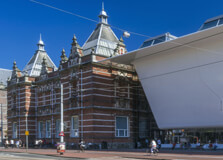
The Stedelijk Museum Amsterdam is one of the most important museums for modern and contemporary art and design in the Netherlands. Located in the Museumplein (Museum Square), near other iconic institutions like the Van Gogh Museum and Rijksmuseum, it showcases an impressive collection of 20th and 21st-century art. With works by artists like Vincent van Gogh, Piet Mondrian, Andy Warhol, and Jackson Pollock, the museum attracts both art lovers and curious visitors from around the world. How to Reach Stedelijk Museum Amsterdam The Stedelijk Museum is located at Museumplein 10, 1071 DJ Amsterdam. It is easy to access by public transport, bicycle, car, or even by walking if you're staying nearby. By Tram: Take tram lines 2, 5, or 12 and get off at the "Van Baerlestraat" stop. The museum is just a short walk from there. By Bus: Bus lines like 347 and 357 stop nearby at Museumplein. By Bicycle: Amsterdam is a bike-friendly city. There are parking areas for bikes near the museum entrance. By Car: Paid parking is available in the Q-Park Museumplein underground garage nearby. From Amsterdam Central Station: Take tram line 2 or 12 for about 15–20 minutes to reach the museum. Weather in Amsterdam Amsterdam experiences a mild oceanic climate, which affects when and how you enjoy your visit: Spring (March to May): Mild weather, blooming flowers, and fewer tourists. Average temperatures range from 8°C to 17°C. Summer (June to August): Warm and pleasant, great for exploring the nearby Museumplein park. Temperatures range from 18°C to 25°C. Autumn (September to November): Cooler with a chance of rain, temperatures drop from 17°C to around 10°C. Winter (December to February): Cold and often wet, with temperatures between 0°C and 7°C. Ideal for indoor attractions like the museum. Timings of Stedelijk Museum Amsterdam Opening Hours: Daily from 10:00 AM to 6:00 PM. Last Admission: Usually 30 minutes before closing. Closed On: The museum is generally open year-round but may close on major holidays like New Year’s Day or King's Day. Why Famous for Stedelijk Museum Amsterdam? The Stedelijk Museum is famous for its extensive collection of modern and contemporary art. It is considered one of the top modern art museums in Europe and globally. Some reasons for its popularity include: Houses works by major 20th-century artists like Kandinsky, Mondrian, Chagall, and Malevich. Includes modern design, applied arts, and graphic design collections. Its temporary exhibitions attract international attention and showcase innovative artists. The building itself is a landmark, especially the modern wing known as "the bathtub" due to its shape. Entry and Visit Details about Stedelijk Museum Amsterdam Ticket Price: Adults: €22.50 Children under 18: Free Students: Discounted rates available with ID I Amsterdam City Card: Free entry included Online Booking: Recommended to avoid queues. Tickets can be purchased via the official website. Facilities: Lockers, restrooms, museum shop, café, and free Wi-Fi available inside. Accessibility: Fully wheelchair accessible with elevators and ramps. History and Architecture The Stedelijk Museum was founded in 1874 by a group of Amsterdam citizens. It originally focused on contemporary Dutch art but later expanded its collection to include international modern and contemporary works. The original building was designed by architect Adriaan Willem Weissman and opened in 1895. It has a classical red-brick façade, similar to the nearby Rijksmuseum. In 2012, a new modern wing was added, designed by Benthem Crouwel Architects. This new extension, often called “The Bathtub” because of its shape, features a sleek, white, futuristic design and greatly increased the museum’s space. The blend of historical and modern architecture reflects the museum’s mission to honor the past while embracing the future of art. Things to Do at Stedelijk Museum Explore the Permanent Collection: View works from movements like De Stijl, Bauhaus, Pop Art, Abstract Expressionism, and Minimalism. Visit Temporary Exhibitions: The museum frequently hosts exhibitions that feature new media, design, and international artists. Enjoy the Stedelijk Café: Relax with coffee or lunch after your visit at the modern and stylish café. Shop at the Museum Store: Pick up art books, prints, souvenirs, and gifts inspired by the museum’s collection. Join a Guided Tour: English tours and multimedia guides are available for a deeper understanding of the artworks. Attend Workshops and Events: Special programs for families, kids, and art students happen regularly. Interesting Facts The Stedelijk was the first museum in the Netherlands to collect photography and video art as part of its core collection. The museum owns one of the world’s largest collections of works by Kazimir Malevich. Its new wing, opened in 2012, increased exhibition space by more than 50%. It also has one of the finest design collections in the world, covering furniture, posters, typography, and everyday objects. The museum’s name “Stedelijk” means “Municipal” in Dutch, showing its origins as a city initiative. Tips for Visiting Stedelijk Museum Amsterdam Buy Tickets in Advance: Booking online can help avoid long queues, especially during weekends and holidays. Allow Enough Time: Spend at least 2–3 hours to enjoy both the permanent and temporary exhibits. Use the Multimedia Guide: These guides offer detailed information and background stories about the artworks. Visit Nearby Attractions: Combine your visit with nearby sites like the Van Gogh Museum, Rijksmuseum, or Vondelpark. Check Exhibition Schedule: Visit the museum’s official website to see what temporary exhibits are on during your visit. Stedelijk Museum Amsterdam is a must-visit for anyone interested in art, design, and culture. Its innovative exhibits, striking architecture, and location in the cultural heart of Amsterdam make it an unforgettable experience for all kinds of travelers.
Explore More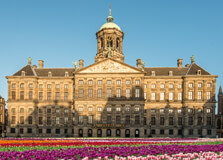
The Royal Palace of Amsterdam, also known as Koninklijk Paleis Amsterdam, is one of the most important historical buildings in the Netherlands. Located on Dam Square in the heart of Amsterdam, this grand palace serves as one of the official residences of the Dutch monarch. Although it is not the everyday home of the royal family, it is used for royal events, state visits, and award ceremonies. When not in use for official functions, the palace is open to the public and offers a fascinating insight into Dutch history, art, and royal life. How to Reach Royal Palace of Amsterdam, Amsterdam Reaching the Royal Palace is very easy due to its central location on Dam Square. By Tram: Take tram numbers 2, 4, 12, 13, 14, or 17 and get off at “Dam Square” stop. The palace is just a short walk from there. By Bus: Several city buses stop near Dam Square. Bus services from Amsterdam Central Station also bring you close. By Foot: From Amsterdam Central Station, it's about a 10-minute walk to Dam Square. By Bicycle: You can easily ride a bike to Dam Square and park at nearby bicycle stands. Weather in Amsterdam Amsterdam experiences a mild, oceanic climate. It’s always good to bring a light jacket or umbrella as the weather can be unpredictable. Spring (March to May): Cool and breezy, temperatures range from 8°C to 17°C. Great for sightseeing. Summer (June to August): Warm and pleasant, with temperatures between 18°C and 25°C. Ideal time for tourists. Autumn (September to November): Mild with occasional rain. Temperatures vary between 10°C and 18°C. Winter (December to February): Cold and damp, with average temperatures around 0°C to 6°C. Less crowded and cozy indoors. Timings of Royal Palace Opening Hours: Usually open daily from 10:00 AM to 5:00 PM. Closed on: Some national holidays and during royal or state functions. It’s best to check the official website before planning your visit. Why Famous for Royal Palace of Amsterdam, Amsterdam? The Royal Palace is famous for its impressive architecture, rich history, and royal connections. It is one of the finest examples of 17th-century Dutch architecture and is often used by the King for official events. It was originally built as a city hall in the 1600s and later became a royal palace. The grand interiors feature chandeliers, marble floors, and paintings by famous artists like Rembrandt's pupils. It is used for official state visits, the King’s New Year receptions, and royal award ceremonies. Visitors can explore the magnificent rooms, including the Council Chamber and Citizens’ Hall. Entry and Visit Details about Royal Palace of Amsterdam Entrance Fee: General admission is around €12.50 for adults. Children under 18 can enter for free. Tickets: Can be purchased at the entrance or online through the official website. Buying online helps skip queues. Audio Guide: Available in multiple languages for free and offers great insights into the palace's rooms and history. Guided Tours: Not always available, but audio tours are very detailed and easy to follow. Accessibility: Wheelchair accessible with elevators. Service dogs are allowed. History and Architecture The Royal Palace was originally built as the Amsterdam City Hall in the Dutch Golden Age. Designed by architect Jacob van Campen, it was completed in 1655. The building reflects Dutch Classicism and was the largest secular building in Europe at the time. In 1808, when Napoleon’s brother Louis Bonaparte was appointed King of Holland, he turned the City Hall into a Royal Palace. Since then, it has remained under royal use. Though the royal family resides in The Hague, the palace in Amsterdam is still used for formal occasions. Architecturally, the building is a masterpiece. The exterior is grand and symmetrical, while the interiors boast Italian marble, huge chandeliers, ceiling frescoes, and symbolic statues. The main hall, called the “Burgerzaal” (Citizen’s Hall), is the highlight, with its massive marble floor map representing the world as known in the 17th century. Things to Do at the Royal Palace Tour the Palace Rooms: Explore majestic rooms such as the Citizens’ Hall, Throne Room, and Council Chamber. Admire the Art and Sculptures: View paintings by Dutch masters and statues by Artus Quellinus. Listen to the Audio Guide: Learn fascinating stories about the rooms, art, and Dutch history. Take Photos: Photography is allowed without flash. Capture the stunning architecture and interior details. Attend Special Exhibitions: The palace occasionally hosts exhibitions about Dutch heritage, royal traditions, or famous historical events. Facts about Royal Palace of Amsterdam The building was once known as the "Eighth Wonder of the World" due to its size and design. The palace stands on 13,659 wooden piles because of Amsterdam’s soft, swampy ground. The world map in the main hall symbolizes the power and reach of the Dutch East India Company. The building is still used for royal events like King Willem-Alexander's New Year reception and foreign state visits. In 2013, King Willem-Alexander was officially introduced as king here during his investiture ceremony. Tips for Visiting Royal Palace of Amsterdam Visit Early: Mornings are less crowded and ideal for taking your time to explore the palace quietly. Buy Tickets Online: This helps you avoid queues, especially in tourist season. Use the Audio Guide: It's free and adds a lot of value to your visit with detailed stories and background. Combine with Nearby Attractions: The palace is close to Dam Square, the Nieuwe Kerk (New Church), Madame Tussauds, and major shopping streets. Check Official Website: Before visiting, check for any closures due to royal events or national holidays. The Royal Palace of Amsterdam is more than just a building—it's a window into the history and grandeur of the Dutch monarchy and Amsterdam’s golden age. Whether you’re interested in art, architecture, or royalty, this palace offers a memorable and enriching experience in the center of the city.
Explore More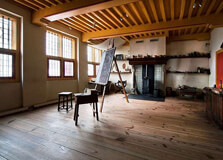
The Rembrandt House Museum (Museum Het Rembrandthuis) in Amsterdam is a unique cultural attraction dedicated to the life and work of the famous Dutch painter Rembrandt van Rijn. The museum is located in the house where Rembrandt lived and worked for nearly 20 years, from 1639 to 1658. Walking through this historic house gives visitors an intimate glimpse into the artist’s personal life, creative process, and the golden era of Dutch art. With its authentic interiors, original etchings, and engaging demonstrations, the museum offers a fascinating experience for art lovers and history enthusiasts. How to Reach Rembrandt House Museum, Amsterdam The Rembrandt House Museum is situated in the center of Amsterdam at Jodenbreestraat 4. It is easily accessible via public transport, walking, or cycling. By Tram: Trams 14 and 9 stop at Waterlooplein, which is a short walk to the museum. By Metro: Metro lines 51, 53, and 54 stop at Waterlooplein station. Exit the station and the museum is just a 2-minute walk away. By Bus: Several buses stop near Waterlooplein or Amsterdam Central Station, which is about 10 minutes away on foot. On Foot or Bicycle: The museum is centrally located, making it easy to walk or cycle from many popular areas in the city. Weather in Amsterdam Amsterdam experiences moderate weather with mild summers and chilly winters. Rain can occur throughout the year, so it’s wise to carry an umbrella or raincoat. Spring (March-May): Pleasant and mild. Ideal for sightseeing, with temperatures between 8°C and 17°C. Summer (June-August): Warm and sunny with occasional rain. Average temperatures range from 18°C to 25°C. Autumn (September-November): Cool and often rainy, with beautiful fall colors. Temperatures drop from 17°C to around 10°C. Winter (December-February): Cold and grey. Temperatures hover around 0°C to 6°C. Great for indoor museums like this one. Timings of Rembrandt House Museum Opening Hours: Open daily from 10:00 AM to 6:00 PM. Closed on: King’s Day (April 27) and some public holidays. Check the official website before visiting for special closures. Why Famous for Rembrandt House Museum, Amsterdam? The museum is famous for being the actual house where Rembrandt lived and created many of his masterpieces. It has been carefully restored to reflect the 17th-century period and offers a real-life look at the world of this great artist. It houses a vast collection of Rembrandt’s etchings and sketches. Live demonstrations show how Rembrandt mixed his paints and printed his etchings. The museum brings you face-to-face with the creative process of one of the greatest painters in European history. It is one of Amsterdam’s most authentic and intimate museums for art lovers. Entry and Visit Details about Rembrandt House Museum Admission Fee: Adults €17.50, Students €14.50, Children under 18 enter free. Special prices apply for groups. Tickets: Can be bought at the door or online. Booking online is recommended to avoid queues. Audio Guide: Included in the ticket, available in several languages. It enhances the experience with stories and explanations. Duration: A typical visit takes 1 to 1.5 hours. Accessibility: The museum has stairs and is partially accessible for wheelchair users. Contact in advance for support. History and Architecture The Rembrandt House was built in the early 17th century and is a fine example of Dutch Renaissance architecture. Rembrandt purchased the house in 1639 at the height of his career. It had multiple levels, a studio, living quarters, and a workshop where he taught pupils. Unfortunately, Rembrandt’s financial troubles forced him into bankruptcy, and he had to move out in 1658. The house changed ownership many times until it was restored and opened as a museum in 1911. The interiors have been recreated based on historical records and inventories taken during the bankruptcy proceedings. This allows visitors to experience the rooms as they were in Rembrandt’s time. Things to Do at the Rembrandt House Museum Explore Rembrandt’s Studio: Step into the room where he painted some of his most famous works. Watch Demonstrations: See how Rembrandt made his etchings and prepared his pigments using 17th-century methods. View Original Art: Discover a vast collection of his etchings and prints, and rotating exhibitions of other artists. Interactive Exhibits: Learn about the history, tools, and techniques of painting and printmaking. Buy Unique Souvenirs: Visit the museum shop for art prints, books, and Rembrandt-themed gifts. Facts about Rembrandt House Museum The house was bought by Rembrandt for 13,000 guilders—an enormous sum at the time. He lived here during the peak of his career, painting works like “The Night Watch.” Over 290 of Rembrandt’s etchings are in the museum’s permanent collection. The museum was restored using actual inventory lists from Rembrandt’s bankruptcy, ensuring historical accuracy. It is located in the former Jewish Quarter of Amsterdam, adding more cultural and historical context to the site. Tips for Visiting the Rembrandt House Museum Book in Advance: The museum is popular and can get crowded. Booking online saves time. Use the Audio Guide: It’s very informative and brings Rembrandt’s story to life. Best Time to Visit: Early morning or late afternoon for a quieter experience. Allow Enough Time: Don't rush. Give yourself at least 1 to 1.5 hours to fully explore and enjoy the museum. Combine Nearby Attractions: The Jewish Historical Museum and Waterlooplein Market are nearby and worth visiting too. The Rembrandt House Museum offers a rare opportunity to walk in the footsteps of one of the greatest artists of all time. It combines history, art, and storytelling in a setting that feels authentic and personal. Whether you are a fan of Rembrandt or simply curious about life in 17th-century Amsterdam, this museum is a must-visit during your trip to the city.
Explore More
The Upside Down Museum in Amsterdam is a one-of-a-kind, interactive experience that combines art, imagination, and social media fun. It’s not your typical museum with paintings on the wall — instead, it’s an immersive world designed to turn your perspective upside down, quite literally! With over 25 rooms filled with illusions, brightly colored installations, and eye-popping decor, this museum is perfect for anyone who loves creativity, photography, and unique experiences. Whether you’re visiting with friends, family, or even solo, this place guarantees fun, laughter, and unforgettable pictures. How to Reach Upside Down Museum, Amsterdam The Upside Down Museum is located near the Amsterdam RAI convention center, which is easily accessible by public transport and other means. By Tram: Take tram number 4 and get off at the 'Europaplein' stop. The museum is just a short walk from there. By Metro: Metro line 52 (Noord/Zuidlijn) also stops at 'Europaplein'. From there, it’s around a 5-minute walk. By Train: From Amsterdam Central Station, take Metro 52. Travel time is around 10 minutes. By Car: There’s paid parking available near the RAI Amsterdam convention center. By Bicycle: Like many places in Amsterdam, the museum is bike-friendly and has designated parking for bicycles. Weather in Amsterdam Amsterdam has a temperate maritime climate. The Upside Down Museum is an indoor attraction, so it's a great place to visit any time of year, especially during rainy or colder days. Spring (March-May): Pleasant with temperatures ranging from 8°C to 17°C. A good time to explore the city. Summer (June-August): Warm with average temperatures between 18°C to 25°C. Popular tourist season. Autumn (September-November): Cooler with temperatures dropping from 17°C to around 10°C. Expect some rain. Winter (December-February): Cold and grey. A perfect time for indoor activities like museum visits. Temperatures hover around 0°C to 6°C. Timings of Upside Down Museum, Amsterdam Opening Hours: Daily from 10:00 AM to 7:00 PM (last entry at 6:00 PM). Holiday Hours: Open year-round, including public holidays. May have extended hours during peak seasons. Why Famous for Upside Down Museum, Amsterdam? The Upside Down Museum is famous for its playful and Instagram-worthy environments. It is not a museum in the traditional sense but a modern, creative space designed to challenge reality, defy gravity, and entertain all ages. It’s Europe’s largest interactive Instagram museum. Every room is a new opportunity for jaw-dropping photos and videos. Visitors are encouraged to touch, explore, pose, and have fun — no silent viewing here! Popular with influencers, photographers, and families alike. Entry and Visit Details about Upside Down Museum Ticket Price: Adults €24.95, Children (3-11 years) €18.95, and free entry for kids under 3. Booking: Tickets must be booked online in advance via the official website or authorized platforms. Visit Duration: On average, visitors spend around 1.5 to 2 hours exploring the museum. Facilities: Includes a café, gift shop, cloakroom, and accessible toilets. Accessibility: The venue is wheelchair accessible and stroller friendly. History and Architecture Opened in 2020, the Upside Down Museum was designed as a response to the growing popularity of visual storytelling through social media. Instead of a traditional museum layout, the founders created a highly visual, interactive environment inspired by art, Dutch culture, and futuristic themes. Architecturally, the museum is housed in a modern building near the business and convention hub of Amsterdam. The interior is creatively designed with themed rooms like an upside-down living room, a giant ball pit, a rainbow hallway, and even a Dutch Royal Room — all created by local designers and artists. The layout is a blend of optical illusions, creative lighting, and immersive technology. Things to Do at the Upside Down Museum Take Photos: Every room is a photo zone. Capture creative shots with optical illusions and funky backdrops. Jump in the Ball Pit: Relive your childhood in a massive ball pit room designed for adults and kids. Explore the Infinity Room: A mirror-lined space that creates stunning visual effects. Visit the Upside Down Rooms: Stand on the ceiling, lie on the walls — gravity doesn’t apply here! Check Out the Café: The in-house café serves trendy drinks and snacks with cool presentation. Facts about the Upside Down Museum, Amsterdam The museum features over 25 interactive spaces. It is the largest Instagram museum in Europe. Each room is designed with a specific theme, from space travel to Dutch culture. It’s a favorite location for influencers and TikTok creators. Photos are encouraged — the staff even help you get the perfect shot if needed! Tips for Visiting the Upside Down Museum Book Online: Tickets are not sold at the door. Booking in advance ensures your preferred time slot. Bring a Fully Charged Phone or Camera: You’ll be taking lots of pictures. Dress Colorfully: Bright clothes pop better in the vibrant rooms for photos. Visit on Weekdays: For a quieter experience, try visiting in the morning during weekdays. Watch Your Step: Some rooms have stairs or unusual floor angles due to the design. The Upside Down Museum is not just a place to view art but to be a part of it. It’s an adventure through creativity, playfulness, and self-expression. Whether you're young or just young at heart, the museum provides an experience unlike any other in Amsterdam. Don't forget your camera — you’ll want to remember every moment!
Explore More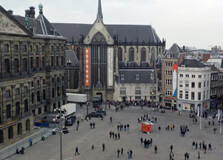
Madame Tussauds Amsterdam is one of the most popular tourist attractions in the city, drawing visitors from around the world who want to get up close and personal with lifelike wax figures of famous celebrities, athletes, world leaders, and fictional characters. Located in the heart of Amsterdam on Dam Square, this museum offers a unique experience where art meets entertainment. Whether you’re interested in Hollywood stars, global icons, or Dutch heroes, this museum is full of photo opportunities, fun interactive displays, and fascinating details about the people represented. How to Reach Madame Tussauds Amsterdam Getting to Madame Tussauds Amsterdam is easy due to its central location at Dam Square. By Tram: Many trams stop at Dam Square, including tram lines 2, 4, 12, 13, 14, and 17. The stop “Dam” is right in front of the museum. By Metro: You can take Metro lines 51, 52, 53, or 54 to “Nieuwmarkt” or “Central Station.” From there, it’s a short walk. By Train: From Amsterdam Central Station, it’s about a 10-minute walk to Dam Square. By Bus: Several city buses stop near Dam Square as well. By Car: Parking in the city center is limited and expensive, but parking garages are available nearby such as the Bijenkorf or Rokin garages. By Bicycle: Like most of Amsterdam, the area is bike-friendly, and there are places nearby to lock up your bicycle. Weather in Amsterdam Since Madame Tussauds is an indoor attraction, you can visit it year-round without worrying about the weather. Still, knowing the climate can help you plan your overall trip. Spring (March to May): Mild weather, flowers in bloom, temperatures between 8°C and 17°C. Summer (June to August): Warm and busy tourist season with temperatures ranging from 18°C to 25°C. Autumn (September to November): Cooler temperatures and some rain. Temperatures range from 10°C to 18°C. Winter (December to February): Cold, with temperatures from 0°C to 6°C. Fewer crowds and festive vibes. Timings of Madame Tussauds Amsterdam Opening Hours: Open daily from 10:00 AM to 6:00 PM (last entry at 5:00 PM). Holiday Hours: Open on most public holidays, but hours may vary. It’s best to check the official website before visiting. Why Famous for Madame Tussauds Amsterdam? Madame Tussauds Amsterdam is famous for its realistic wax figures and engaging, interactive exhibits. It's part of the world-renowned Madame Tussauds brand that started in London and has since expanded to cities around the globe. It features incredibly lifelike wax statues of celebrities, including Dutch personalities, musicians, sports icons, and historical figures. Visitors can pose with their favorite stars like Beyoncé, Taylor Swift, Van Gogh, Barack Obama, and more. The museum includes fun themes like Marvel superheroes, movie sets, and pop culture scenes. It’s both entertaining and educational, offering background stories and facts about the personalities featured. Entry and Visit Details about Madame Tussauds Amsterdam Ticket Price: Prices vary depending on time and day, but generally start around €23 for adults and €19 for children (online rates). Booking: It’s strongly recommended to book tickets online to skip the queue and often save money. Visit Duration: A typical visit lasts 1 to 1.5 hours. Accessibility: The museum is wheelchair accessible, with elevators and support available on request. Facilities: On-site restrooms, a small souvenir shop, and helpful multilingual staff. History and Architecture Madame Tussauds Amsterdam opened its doors in 1970, becoming the first Madame Tussauds museum outside the United Kingdom. Since then, it has grown in popularity and undergone several modernizations to keep up with contemporary trends and technology. The building is located in a historic area overlooking Dam Square, one of Amsterdam's most iconic spots. While the structure itself isn’t ancient, it blends well with the traditional and classical architecture that surrounds the square. Inside, the museum is modern, clean, and cleverly designed with themed rooms, vibrant lighting, and realistic sets that enhance the visitor experience. Things to Do at Madame Tussauds Amsterdam Take Selfies with Celebs: Pose with wax versions of Rihanna, Ariana Grande, Brad Pitt, and even Dutch royalty. Marvel Zone: Get up close with superheroes like Hulk, Spider-Man, and Iron Man in action-packed scenes. Enter the Music Zone: Stand on stage with Lady Gaga or DJ at a virtual dance party. Explore the History Room: Learn about great minds like Einstein and political figures like Nelson Mandela. Strike a Pose: Whether it’s on a royal throne or a red carpet, the museum encourages you to be part of the scene. Facts about Madame Tussauds Amsterdam Each wax figure can take up to 6 months to make and cost over €200,000 to create. The museum houses over 100 wax figures at any given time. It’s the first Madame Tussauds to include Dutch celebrities and historical figures like Rembrandt and Anne Frank. The museum uses 3D scanning and modern sculpting techniques for lifelike accuracy. It was the first Madame Tussauds museum to open in mainland Europe. Tips for Visiting Madame Tussauds Amsterdam Visit Early or Late: To avoid crowds, go right after opening or during the last hour before closing. Buy Tickets Online: It’s cheaper and helps you skip long queues. Bring a Camera or Smartphone: Photography is encouraged, and there are great selfie spots everywhere. Check for Combo Deals: You can often save money by buying tickets combined with other Amsterdam attractions. Engage with Staff: Friendly staff members often help visitors take fun photos and provide useful information. Madame Tussauds Amsterdam offers more than just wax figures. It’s a playful, engaging experience for people of all ages and interests. Whether you’re a fan of movies, history, music, or sports, this museum offers a slice of stardom and entertainment in the heart of Amsterdam. Don’t forget to charge your phone — you’ll want plenty of photos!
Explore More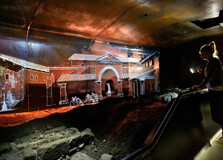
DOMunder is one of the most unique and fascinating attractions in Utrecht, Netherlands. Located right beneath Domplein (Dom Square), it offers an unforgettable journey through 2,000 years of Dutch history. Visitors can explore ancient Roman ruins, medieval artifacts, and remnants of the 1674 storm that destroyed part of the historic Dom Church. DOMunder combines history, archaeology, and modern interactive technology to bring the past to life. It’s a must-see destination for anyone interested in history, culture, and storytelling. How to Reach DOMunder, Utrecht DOMunder is located directly beneath Domplein, right between the Dom Tower and St. Martin’s Cathedral in the center of Utrecht. It’s very accessible by public transport and easy to find. By Train: From Amsterdam, Rotterdam, or The Hague, take a train to Utrecht Centraal Station. From there, it’s a short 10-15 minute walk to Domplein. By Bus: Several city buses stop near the city center. Look for routes that stop at Janskerkhof or Neude, which are both close to DOMunder. By Car: Parking is limited in the city center. It’s recommended to use one of Utrecht’s Park & Ride (P+R) services and take public transport into the city. By Bicycle: Utrecht is a bike-friendly city, and there are bicycle parking areas close to Domplein. Weather in Utrecht Since DOMunder is mostly underground, the weather outside doesn’t affect the experience much. However, here’s what you can expect while planning your trip: Spring (March-May): Mild weather, ideal for exploring the city before or after your DOMunder visit. Summer (June-August): Warm temperatures and more daylight make this a popular time for tourists. Book in advance. Autumn (September-November): Cooler and wetter, but still a good time to visit indoor attractions like DOMunder. Winter (December-February): Cold and damp. DOMunder offers a cozy, weatherproof activity during the colder months. Timing and Entry Details DOMunder is open to visitors throughout the week, but tour times are fixed and reservations are recommended. Opening Hours: Usually open from Tuesday to Sunday, 10:30 AM – 5:00 PM. Closed on Mondays. Tour Times: Guided tours are available in Dutch and English, typically every hour. Check the website for up-to-date schedules. Entry Fee: Adults: approx. €13.50, Students: €11, Children (6–12): €7.50. Children under 6 are not allowed due to safety reasons. Tickets: Advance booking is highly recommended, especially in summer and on weekends. Tickets can be booked online. Why Famous for DOMunder, Utrecht? DOMunder is famous for being an interactive time-travel experience that reveals the deep and complex history beneath Utrecht’s surface. It’s located on one of the most historically significant sites in the Netherlands. What makes DOMunder truly unique is its combination of archaeology, storytelling, and digital technology. Visitors use a smart torch (flashlight with sensors) to interact with objects and digital displays. You can explore ruins from the Roman Castellum Traiectum, Gothic cathedral foundations, and witness damage caused by the 1674 tornado that destroyed the church nave. This immersive experience makes history feel alive. History and Architecture The DOMunder site has layers of history dating back over 2,000 years. In Roman times, this location was home to a fortress known as Castellum Traiectum, built around 47 AD to defend the Roman Empire’s northern border. The fort later evolved into a religious and political center during the Middle Ages. In the 13th century, the Dom Church and Dom Tower were built on this same site, making it a vital part of religious life in Utrecht. In 1674, a severe storm caused the collapse of the cathedral’s nave. The ruins were never rebuilt, and Domplein became an open square. The DOMunder project began in 2003 with archaeological excavations and officially opened to the public in 2014. Modern architecture has been used to protect and showcase the ancient ruins while blending them with digital storytelling tools. Things to Do at DOMunder Join the Underground Tour: Follow the guided tour and explore the historical layers of Utrecht using the interactive flashlight. Learn About Roman Life: See real Roman walls and artifacts, and learn about the lives of Roman soldiers stationed here. Experience the Storm of 1674: A digital simulation recreates the moment the cathedral was destroyed, immersing visitors in history. Visit the Gift Shop: Buy books, souvenirs, and educational materials about Utrecht and Dutch history. Explore Domplein: After your tour, walk around the square above and visit the Dom Church and Dom Tower for a complete historical experience. Interesting Facts DOMunder took more than a decade of planning, excavation, and construction before opening in 2014. The Roman fort beneath Domplein was part of the Limes, the former northern boundary of the Roman Empire, now a UNESCO World Heritage site. Visitors use a high-tech flashlight to activate stories and projections during the tour. DOMunder hosts occasional events, night tours, and school programs to bring history to new audiences. The location is still an active archaeological site, with new discoveries being made during deeper excavations. Tips for Visiting DOMunder, Utrecht Book your tickets online in advance, especially during weekends and school holidays. Wear comfortable shoes — the underground floor can be uneven in places. Arrive early to check in and explore the area around Domplein before your tour starts. Bring a light jacket, as the underground area can be cool, even in summer. Combine your visit with the Dom Tower, Dom Church, and Utrecht University Museum for a full day of history and culture.
Explore More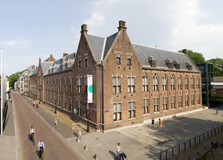
The Centraal Museum in Utrecht is one of the oldest municipal museums in the Netherlands and a treasure trove of Dutch art, design, and culture. Established in 1838, it is home to an extensive and diverse collection that ranges from medieval religious art to contemporary design, fashion, and even the world-famous creations of Utrecht's own Gerrit Rietveld. The museum also manages other iconic Utrecht attractions like the Rietveld Schröder House and the Miffy Museum. With its unique exhibits and rich historical background, the Centraal Museum offers something for every kind of visitor, from history lovers to art enthusiasts. How to Reach Centraal Museum, Utrecht Located just south of the city center, the Centraal Museum is easily accessible by various modes of transport. By Train: Travel to Utrecht Centraal Station, the main railway hub. From there, it’s about a 20-minute walk or a short bus ride. By Bus: Bus numbers 2, 8, and 28 stop close to the museum at the "Centraal Museum" or "Tolsteegbrug" stops. By Car: Parking in the museum area is limited, but there are parking garages nearby, such as Vaartsche Rijn or Springweg. By Bicycle: Utrecht is a cycling city, and you can reach the museum easily via dedicated bike lanes. Bike parking is available at the entrance. Weather in Utrecht Since most of the museum's experience is indoors, the weather won’t affect your visit much. However, here is a general idea of what to expect: Spring (March to May): Mild temperatures and blossoming flowers make for a pleasant time to visit. Average temperatures range from 8°C to 17°C. Summer (June to August): Warm and lively, with average temperatures between 18°C to 25°C. A good time for combining museum visits with city exploration. Autumn (September to November): Cooler and often rainy, but cozy for indoor cultural activities like museum visits. Winter (December to February): Cold and occasionally snowy, but the museum is comfortably heated and open all year round. Timings and Entry Details The Centraal Museum welcomes visitors throughout the week with the exception of a few holidays. Opening Hours: Tuesday to Sunday from 11:00 AM to 5:00 PM. Closed on Mondays (except for some public holidays). Entry Fee: Adults: €15, Students: €12, Children under 18: Free. The Museumkaart is accepted for free entry. Tickets: Tickets can be purchased online or at the entrance. Online booking is advised during weekends or special exhibitions. Accessibility: The museum is accessible for wheelchairs and strollers. Elevators and accessible restrooms are available. Why Famous for Centraal Museum, Utrecht? The Centraal Museum is famous for its impressive and wide-ranging collection that reflects Utrecht’s artistic legacy. It houses major works from Utrecht Caravaggisti painters like Hendrick ter Brugghen and Gerard van Honthorst, offering visitors a rare glimpse into Dutch Golden Age painting with an Italian twist. It’s also celebrated for its fashion and costume collections, as well as modern art and design. One of the museum’s major draws is its association with Gerrit Rietveld, a pioneer of the De Stijl movement. The museum owns the original Red and Blue Chair and oversees the Rietveld Schröder House, a UNESCO World Heritage Site. History and Architecture The Centraal Museum was officially founded in 1838, making it one of the oldest city museums in the Netherlands. It is housed in a former medieval monastery, and the architecture of the building reflects this rich history. The old monastic structure blends beautifully with modern extensions added over time. The museum’s layout is a combination of historical spaces and contemporary galleries. The internal courtyard is particularly scenic and often hosts temporary installations and sculptures. The mix of old and new architecture symbolizes Utrecht’s ongoing relationship between history and innovation. Things to Do at Centraal Museum Explore Dutch Art: Admire paintings from the Utrecht Caravaggisti and Golden Age artists. Visit the Rietveld Collection: See iconic furniture pieces like the Red and Blue Chair and learn about De Stijl design. Fashion and Costume Section: View centuries of Dutch fashion, including modern Dutch designers. Temporary Exhibitions: Discover new and rotating exhibitions on contemporary art, history, and design. Courtyard and Café: Relax in the museum café or enjoy a coffee in the historical courtyard. Interesting Facts The museum has more than 50,000 objects in its collection, spanning over 1,000 years of Dutch history. It oversees the Miffy Museum (Nijntje Museum), dedicated to Dick Bruna's iconic children’s character. The Rietveld Schröder House, managed by the museum, is a UNESCO World Heritage Site. The museum also features archaeological finds from Utrecht's medieval past. Every few months, a different Utrecht-based artist is invited to create a site-specific work for the museum. Tips for Visiting Centraal Museum, Utrecht Buy tickets online in advance if visiting during weekends or public holidays. Allow at least 2–3 hours to fully explore the museum and its exhibits. Visit the Rietveld Schröder House (located a short distance away) for a deeper understanding of modernist Dutch architecture. Check for special exhibitions and events on the museum's official website before your visit. Don’t miss the museum shop — it has a great collection of art books, Dutch design gifts, and local souvenirs.
Explore MoreBeloved Europe 5 Nights - 6 Days Tour
6 Days/ 5 Night
Amsterdam - Prague - Frankfurt
Amsterdam And Berlin 4 Nights - 5 Days Tour
5 Days/ 4 Night
Berlin - Amsterdam
European Discovery Classic 11 Nights - 12 Days Tour
12 Days/ 11 Night
Paris - Venice - Florence - Munich - Amsterdam - Innsbruck - Rome - Lucerne
Glimpses Of Europe Land Only 8 Nights - 9 Days Tour
9 Days/ 8 Night
Paris - Amsterdam - Zurich - Frankfurt
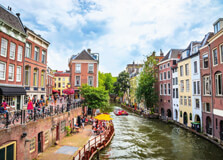
The Old Canal, known in Dutch as Oudegracht, is the heart and soul of Utrecht. Stretching through the city center, this iconic canal is famous for its unique structure, historical importance, and vibrant atmosphere. With charming bridges, centuries-old buildings, wharf cellars, and waterside restaurants, Oudegracht is one of the most scenic and lively places to explore in the Netherlands. It’s a perfect blend of medieval history, local culture, and modern life. Whether you're strolling along the banks, taking a boat tour, or dining at a canal-side café, the Old Canal offers an unforgettable experience. How to Reach Old Canal Utrecht The Old Canal runs through the heart of Utrecht, making it easily accessible from various parts of the city and the country. By Train: Take a train to Utrecht Centraal Station. From there, it's a 5–10 minute walk to the Old Canal area. By Bus: Many local buses stop near Neude or Janskerkhof, which are close to the canal. By Car: Driving is possible, but the city center has limited parking. Use nearby parking garages like Springweg or Paardenveld. By Bicycle: Utrecht is a bike-friendly city. There are bike paths leading to and along the canal with parking spaces nearby. Weather in Utrecht The Old Canal can be visited year-round, but your experience may vary depending on the season. Spring (March to May): A lovely time with flowers blooming and pleasant temperatures ranging from 10°C to 18°C. Summer (June to August): The most popular time with warm, sunny days (18°C to 25°C). Great for outdoor dining and boat tours. Autumn (September to November): Cooler and occasionally rainy, but the fall colors along the canal are stunning. Winter (December to February): Cold and often wet. Still beautiful, especially with festive lights during the holiday season. Timings and Entry Details The Old Canal is a public space, so you can visit it at any time of the day or night without an entry fee. However, some attractions and activities along the canal may have specific opening hours. Open Hours: 24/7 (public access) Boat Tours: Usually operate from 10:00 AM to 6:00 PM, depending on the season and weather. Restaurants and Cafés: Most are open between 11:00 AM and 11:00 PM. Timings may vary on weekends and holidays. No Entry Fee: Walking along the canal is free. Charges apply for tours, food, or specific events. Why Famous for Old Canal Utrecht? The Old Canal is famous for its historical layout and unique two-level canal system. Unlike other Dutch canals, Oudegracht features wharf cellars at water level which were originally used for storage and trade in the Middle Ages. Today, these cellars house trendy cafes, shops, and art galleries. It’s also known for being incredibly picturesque. With its quaint bridges, lush greenery, and vibrant city life, it’s a favorite spot for both locals and tourists. The canal also hosts events such as the Utrecht Canal Pride and the annual SingelSwim charity event. History and Architecture The Old Canal dates back to the 12th century when it was dug as a branch of the Rhine River to control water flow and support trade. By the 13th century, wharfs and warehouses were constructed along the canal. A system of cellars below street level was developed to allow goods to be easily transferred from boats to storage areas. Architecturally, the canal area features a mix of medieval, Renaissance, and modern Dutch styles. Many historic buildings, including merchant houses and warehouses, have been beautifully preserved or repurposed. Walking along the canal is like walking through Utrecht’s timeline. Things to Do at Old Canal Utrecht Boat Tours: Take a guided cruise or rent a paddle boat to enjoy the canal from the water. Dine Along the Canal: Enjoy lunch or dinner in one of the many wharf cellar restaurants or terraces. Shopping: Discover boutique shops and artisan stores located along the canal streets. Photography: The canal provides a perfect backdrop for photography, especially during golden hour. Walk or Cycle: Explore the entire length of the canal, from the city center to the southern and northern ends. Visit Museums: Nearby attractions include the Centraal Museum, DOMunder, and Museum Speelklok. Interesting Facts The Oudegracht stretches about 2 kilometers through the city center of Utrecht. Some wharf cellars are over 700 years old and are now used as homes or businesses. The canal system includes locks and sluices that help manage water levels. The Oudegracht has been featured in many Dutch films and TV shows due to its beauty. In the winter, if the canal freezes, locals sometimes go ice skating on it. Tips for Visiting Old Canal Utrecht Visit early in the morning or around sunset for the best light and fewer crowds. Try a canal-side lunch at a cellar restaurant for a unique dining experience. Bring a camera — this area is one of the most photogenic parts of Utrecht. Wear comfortable shoes for walking along the cobbled streets and bridges. If possible, visit during one of the local festivals or events held near the canal.
Explore More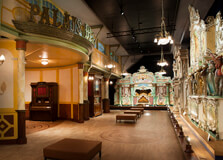
Museum Speelklok, located in the heart of Utrecht, is one of the most enchanting museums in the Netherlands. Known as the "self-playing musical instrument museum," it’s home to a delightful collection of music boxes, barrel organs, self-playing pianos, and other mechanical musical instruments that once brought joy to homes, streets, and cafés across Europe. The museum is interactive, fun for all ages, and offers a unique experience that blends technology, history, and music in a vibrant and joyful way. Whether you’re a music lover or simply looking for a unique cultural attraction, Museum Speelklok is sure to surprise and entertain. How to Reach Museum Speelklok, Utrecht Museum Speelklok is centrally located in Utrecht and easy to reach by various modes of transport: By Train: From Utrecht Centraal Station, the museum is a short 10-minute walk through the city center. By Bus: Several city buses stop near the museum. The nearest stops include Janskerkhof and Neude. By Car: The museum is in a pedestrian area, but nearby parking garages include Paardenveld and Springweg. By Bicycle: Utrecht is a cycling city. Bike parking is available near the museum entrance. Weather in Utrecht Since Museum Speelklok is an indoor attraction, it's perfect for visiting any time of the year. However, knowing the general weather can help you plan your travel and nearby outdoor exploration. Spring (March to May): Mild and pleasant, temperatures range between 10°C to 18°C. Great for exploring nearby streets after your museum visit. Summer (June to August): Warm and lively. Temperatures range from 18°C to 25°C, making it ideal for walking around the old town area. Autumn (September to November): Cooler with some rain, but the fall atmosphere adds charm to the historic center. Winter (December to February): Cold and often wet, but the museum is warm and festive, especially during the holiday season. Timings and Entry Details Museum Speelklok is open almost all year and welcomes visitors of all ages. Opening Hours: Tuesday to Sunday from 10:00 AM to 5:00 PM. Closed on Mondays and major holidays like King's Day and Christmas Day. Entry Fee: Adults €15, Children (4–12 years) €8, Children under 4: Free. Discounts available for students and Museumkaart holders. Guided Tours: Guided tours are included in the entry price and highly recommended to fully enjoy the instrument demonstrations. Accessibility: The museum is wheelchair-friendly and has accessible restrooms and elevators. Why Famous for Museum Speelklok, Utrecht? Museum Speelklok is world-famous for its collection of self-playing musical instruments. From tiny music boxes to enormous fairground organs, each piece is a mechanical marvel that plays live music without a human performer. The museum brings history to life through sound, showcasing the evolution of automated music from the 17th century to today. What sets the museum apart is its cheerful, hands-on approach. Visitors can listen to live demonstrations, interact with exhibits, and even watch restorers at work in the museum’s repair workshop. It’s an immersive experience that appeals to both kids and adults. History and Architecture Museum Speelklok is housed in the former Buurkerk, a medieval church dating back to the 11th century. The church itself is an architectural gem with high vaulted ceilings, stone columns, and stunning stained-glass windows. After serving as a religious site for centuries, it was transformed into a museum in the 1980s. The combination of historical architecture with playful musical exhibits creates a special ambiance. The contrast between the solemn church setting and the joyful music machines makes the experience even more memorable. Things to Do at Museum Speelklok Take a Guided Tour: Enjoy live demonstrations of barrel organs, orchestrions, and self-playing pianos during the interactive tour. Explore the Exhibits: Learn about how mechanical music works and its cultural role in European history. Visit the Restoration Workshop: Watch skilled technicians restore antique instruments to working condition. Children’s Area: The museum offers playful and educational activities for children, including music games and puzzles. Attend a Special Exhibition: The museum regularly hosts themed temporary exhibitions focused on music and innovation. Browse the Gift Shop: Find unique music-related souvenirs and charming gift items for all ages. Interesting Facts The name “Speelklok” means “musical clock” in Dutch. One of the museum’s oldest pieces is a 15th-century bell chime that still works. The museum’s fairground organs can fill the entire hall with music using only air and punched paper rolls. Museum Speelklok has inspired similar musical instrument museums in other parts of Europe. Many of the instruments were once used in churches, homes, and even on the streets to entertain people before radios and record players existed. Tips for Visiting Museum Speelklok Take the guided tour — it’s the best way to hear the instruments in action and understand their stories. Visit early in the day to avoid crowds, especially on weekends and school holidays. Combine your visit with nearby attractions like the Dom Tower, Oudegracht canal, or DOMunder. Check the museum’s website for temporary exhibitions or musical performances during your visit. If traveling with children, don’t miss the kids’ play zone and family-friendly tours.
Explore More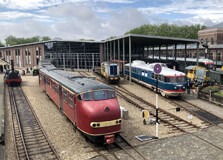
The Railway Museum, known in Dutch as Het Spoorwegmuseum, is one of the most exciting and family-friendly attractions in Utrecht. Located just outside the city center, this museum brings the history of trains to life with interactive exhibits, beautifully restored locomotives, and immersive storytelling. Whether you're a railway enthusiast or a curious traveler, the museum offers an unforgettable journey through time, from the earliest steam engines to modern high-speed trains. It’s a place where technology, history, and fun come together for visitors of all ages. How to Reach Railway Museum, Utrecht The Railway Museum is very easy to reach from Utrecht and other parts of the Netherlands: By Train: A special train runs from Utrecht Centraal Station directly to the museum's own train station: Utrecht Maliebaan. The ride is short and scenic. By Bus: Buses from the city center or Utrecht Centraal stop nearby. The closest stops are at 'Maliebaan' or 'Oosterkade'. By Car: Parking is available next to the museum. Just follow signs for “Het Spoorwegmuseum”. Note that parking is paid. By Bicycle: Utrecht is a cycling city, and there are bike paths leading directly to the museum. Bike parking is available on site. Weather in Utrecht The Railway Museum has both indoor and outdoor sections, so weather can influence part of your experience. Spring (March to May): A great time to visit with blooming flowers and mild weather (10°C to 18°C). Summer (June to August): Warm and ideal for outdoor parts of the museum. Expect temperatures from 18°C to 25°C. Autumn (September to November): Cooler and often rainy. Bring an umbrella or raincoat just in case. Winter (December to February): Cold and sometimes snowy. The indoor exhibits are warm and comfortable year-round. Timings and Entry Details The Railway Museum is open almost all year with special events during holidays. Opening Hours: Tuesday to Sunday from 10:00 AM to 5:00 PM. Closed on Mondays (except holidays and school vacations). Entry Fee: Adults €19, Children (4–11 years) €16, Children under 4 are free. Museumkaart holders enter for free. Tickets: Tickets can be purchased online or at the entrance. Booking online is recommended during peak times. Accessibility: The museum is accessible for wheelchairs and strollers. Facilities include lifts, ramps, and accessible restrooms. Why Famous for Railway Museum, Utrecht? The Railway Museum is famous for its impressive collection of historic trains and its entertaining, educational exhibits. Unlike traditional museums, it allows you to walk through, climb on, and explore the trains themselves. It brings Dutch railway history to life in a playful and immersive way. The museum also features themed sections like a 19th-century station hall, a theater experience inside a train, and a “steel monsters” room showcasing massive engines. The blend of storytelling, technology, and real artifacts makes it a top attraction not only in Utrecht but in all of the Netherlands. History and Architecture The museum is housed in the former Maliebaan Station, which dates back to 1874. This beautiful building has been restored to reflect the style of a classic 19th-century train station, with vintage signs, ticket booths, and waiting rooms. The original platform is still in use and adds an authentic atmosphere to the museum. Since opening as a museum in 1954, the site has been expanded to include several large halls and outdoor tracks. Each area is themed, with architecture reflecting different time periods in railway history. The attention to detail in both trains and buildings makes it a fascinating walk through the evolution of Dutch transportation. Things to Do at Railway Museum, Utrecht Explore Historic Trains: Walk inside royal carriages, old steam locomotives, and classic dining cars. Train Ride Experience: Take a short ride on a museum train that shows how trains used to operate. Steel Monsters Exhibition: See the power of large industrial engines and learn about train technology. Play Area for Kids: There’s a large indoor playground where kids can play while learning about trains. Theatre Journey: Go on an audio-visual adventure inside a moving train that tells railway stories with lights, sound, and animation. Café and Gift Shop: Enjoy coffee or lunch in a stylish café and buy train-themed souvenirs in the shop. Interesting Facts The museum owns more than 100 railway vehicles, including trains from as early as 1839. It is the only museum in the Netherlands with its own operational train station (Utrecht Maliebaan). One of the museum's oldest pieces is “De Arend,” a replica of the first Dutch steam locomotive. The museum often hosts events like Thomas the Train days, night museum openings, and steam festivals. In 2020, the museum was nominated for the European Museum of the Year Award. Tips for Visiting Railway Museum, Utrecht Buy tickets online to avoid lines, especially during school holidays. Wear comfortable shoes — you’ll be walking a lot through large halls and outdoor areas. Combine your visit with a walk along the nearby canals or visit to the Centraal Museum. If visiting with kids, plan to stay for 3–4 hours — there’s a lot to see and do. Don’t miss the live train demonstrations and check the schedule at the entrance for special shows.
Explore More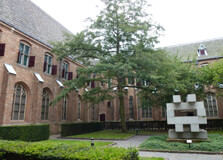
St. Catherine’s Convent Museum
St. Catherine’s Convent Museum (Dutch: Museum Catharijneconvent) is a nationally recognized museum located in the beautiful city of Utrecht, Netherlands. This museum is dedicated to showcasing the history of Christianity in the country through an exceptional collection of religious art and artifacts. Housed in a former medieval monastery, the museum not only offers insight into spiritual traditions but also preserves centuries-old architecture, making it a unique destination for both art lovers and history enthusiasts. How to Reach St. Catherine’s Convent Museum, Utrecht The museum is located at Lange Nieuwstraat 38, 3512 PH Utrecht. It’s centrally positioned and easily accessible: By Train: Utrecht Central Station is the nearest major station, just a 10-minute walk from the museum. By Bus: Multiple bus lines stop near the museum, including buses 2 and 8. By Car: Although driving is possible, parking in central Utrecht can be limited. Nearby parking garages include Springweg and Kruisstraat. By Bicycle: As Utrecht is a bicycle-friendly city, cycling to the museum is a pleasant and eco-friendly option. Weather in Utrecht Utrecht experiences a mild maritime climate: Spring (March-May): Cool and pleasant with temperatures between 8°C and 18°C. Summer (June-August): Warm and comfortable, ranging from 17°C to 25°C. Perfect for walking tours. Autumn (September-November): Temperatures begin to cool (10°C to 18°C) with increased rainfall. Winter (December-February): Cold, ranging from -1°C to 6°C. Snow is rare but possible. Visitors should carry an umbrella or rain jacket year-round due to frequent light rain showers. Timing The museum is open throughout the week except on Mondays: Tuesday to Sunday: 10:00 AM – 5:00 PM Closed on Mondays (except during public holidays) Special openings: The museum may have extended hours during temporary exhibitions or events. Check the official website before planning your visit. Why is St. Catherine’s Convent Museum Famous? St. Catherine’s Convent Museum is famous for its unparalleled collection of Christian religious artifacts from the Netherlands. It holds: Stunning medieval manuscripts, sculptures, and altarpieces. Liturgical robes and relics from various time periods. Modern religious art, bridging ancient and contemporary Christian expression. Thematic exhibitions that explore societal values and faith through art. The museum is also known for its immersive exhibitions that engage visitors with stories behind the objects, making it more than just an art display—it's a journey through Dutch religious and cultural history. Entry and Visit Details Visitors can purchase tickets at the museum or online in advance. Ticket options include: Adults: Around €15 Students and seniors: Discounted rates available Children under 13: Usually free Museumkaart holders: Free entry Guided tours can be booked for groups, and audio guides are available in Dutch and English. The museum is wheelchair accessible, with lifts and accessible restrooms available. History and Architecture The museum is housed in a former convent dating back to the 15th century. It was once the site of a Carmelite monastery and later a hospital. The Gothic-style structure has been carefully preserved, with features such as: Vaulted ceilings and stone arches Beautiful stained glass windows Historic cloisters and chapels The museum has been modernized without losing its historical charm, blending old-world architecture with contemporary design to create a serene and reflective atmosphere. Things to Do There are plenty of enriching activities at St. Catherine’s Convent Museum: Explore permanent and temporary exhibitions on Christianity’s evolution in the Netherlands. Attend workshops or lectures on religious art and history. Visit the museum shop for books, souvenirs, and religious artifacts. Relax in the peaceful courtyard or enjoy coffee at the museum café. Families with children can also enjoy interactive exhibits and scavenger hunts designed to make history fun and educational. Facts and Tips about St. Catherine’s Convent Museum The museum is the only one in the Netherlands solely dedicated to Christian art and heritage. It holds over 90,000 objects, including art, manuscripts, and rare books. Check for special exhibitions, as they often bring in rare items from other parts of the world. Photography is generally allowed but without flash. Some special exhibits may have restrictions. To avoid crowds, visit early in the morning or during weekdays. Combine your visit with a walking tour of Utrecht’s old town for a full cultural experience.
Explore More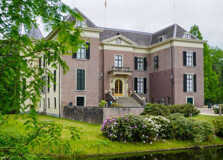
Huis Doorn is a historic manor house located in the town of Doorn, Utrecht, Netherlands. Once the residence of the exiled German Emperor Wilhelm II, it is now a museum showcasing his personal belongings and life in exile. Surrounded by a beautifully landscaped park, the estate offers insights into early 20th-century history and the emperor's lifestyle. How to Reach Huis Doorn, Utrecht Huis Doorn is situated at Langbroekerweg 10, 3941 MT Doorn, Netherlands. The town of Doorn is approximately 30 kilometers southeast of Utrecht, making it easily accessible by various modes of transportation: By Train: From Utrecht Central Station, take a train to Driebergen-Zeist Station. From there, you can take a bus or taxi to Doorn. By Car: Drive via the A12 highway and follow signs to Doorn. Parking is available near the museum. By Bicycle: For cycling enthusiasts, Doorn is accessible via well-maintained bike paths from Utrecht. It's advisable to check local transportation schedules for the most convenient routes. Weather in Doorn Doorn experiences a temperate maritime climate with mild summers and cool winters. Average temperatures range from 3°C in January to 17°C in July. Rain is evenly distributed throughout the year, so it's recommended to carry an umbrella or raincoat when visiting. Timing Museum Huis Doorn is open during the following hours: Tuesday to Sunday: 1:00 PM – 5:00 PM Closed: Mondays, King's Day (April 26), Christmas Day, New Year's Eve, and New Year's Day Park Access: The park surrounding the manor is freely accessible daily from 7:00 AM to 7:00 PM. Please note that the ticket office closes at 4:00 PM. Online booking is recommended for special tours. Why is Huis Doorn Famous? Huis Doorn is renowned for its association with Wilhelm II, the last German Emperor, who lived in exile here from 1920 until his death in 1941. The manor house remains preserved as it was during his time, offering a rare insight into the life of a monarch in exile. Visitors can explore rooms furnished with original pieces, including his study, bedroom, and the Gobelin Room. Entry and Visit Details Admission fees are as follows: Adults: €17.50 Students and Seniors: Discounted rates available Children under 13: Free Museumkaart holders: Free entry For a more in-depth experience, visitors can book the "Servants’ Quarters Tour," which provides a glimpse into the lives of the staff who served Wilhelm II. This tour is available every Sunday at noon, with additional tours during school holidays. Online booking is required for this special tour. History and Architecture Huis Doorn was originally built in the 13th century and has undergone several reconstructions, with the current structure dating back to the 19th century. The manor is designed in a neoclassical style, featuring a symmetrical façade, large windows, and a central entrance. The surrounding park is designed in the English landscape style, with winding paths, water features, and mature trees, providing a serene setting for the estate. Things to Do Visitors to Huis Doorn can: Explore the museum: Tour the rooms furnished as they were during Wilhelm II's residence. Visit the mausoleum: Pay respects at the emperor's final resting place within the park. Walk through the park: Enjoy the beautifully landscaped grounds surrounding the manor. Attend special events: Participate in themed tours and exhibitions held throughout the year. Facts and Tips about Huis Doorn Preserved Interiors: The manor house has been preserved to reflect the time when Wilhelm II resided there, offering an authentic historical experience. Annual Commemoration: Every June, German monarchists gather to pay their respects to Wilhelm II, highlighting the site's continued historical significance. Photography: Photography is allowed in most areas; however, flash photography is prohibited to preserve the artifacts. Accessibility: The museum is wheelchair accessible, with ramps and elevators available for visitors with mobility impairments. Combine Visits: Consider visiting nearby attractions in Doorn, such as the Utrechtse Heuvelrug National Park, to make the most of your trip. For more information, visit the official website: https://www.huisdoorn.nl/en/plan-your-visit/opening-hours-tickets/
Explore More